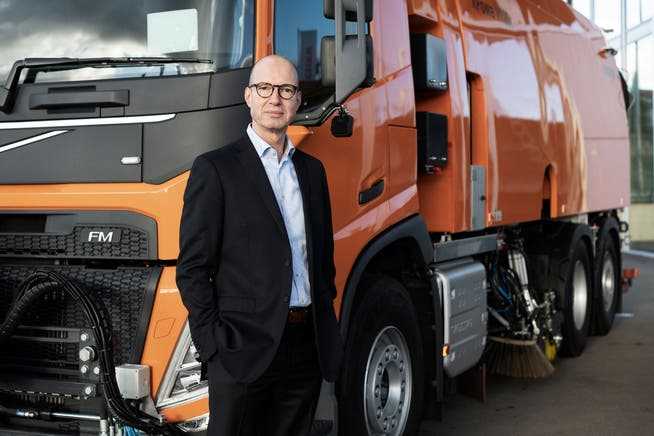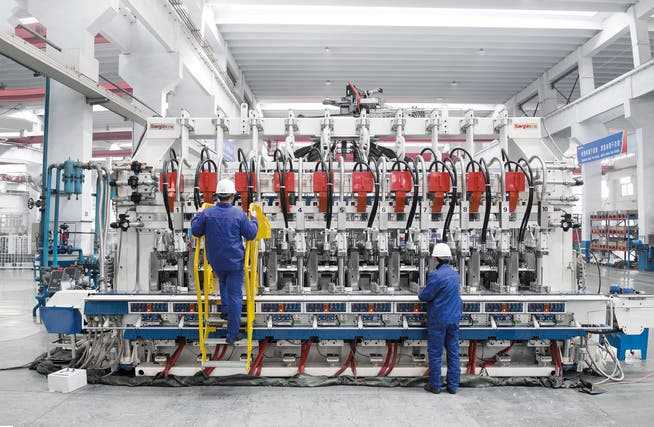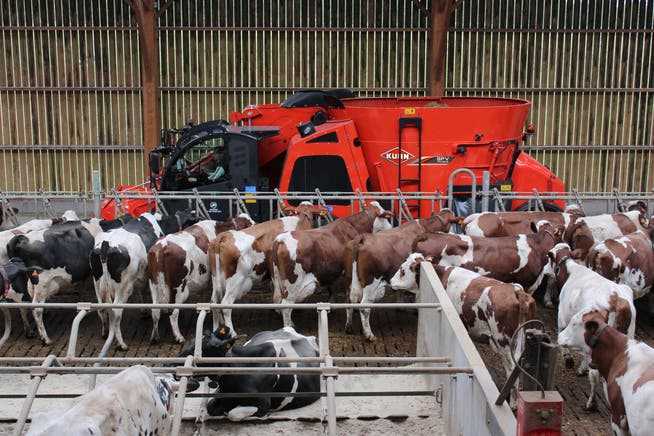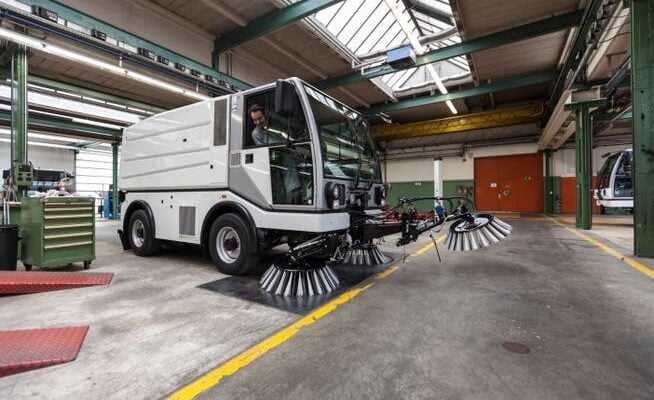There are fewer and fewer conglomerates. But Bucher proves that you can also be successful with five different branches. The company helps that the founding family holds the line in the seventh generation.
Bucher Industries maintains a service workshop for municipal vehicles at its headquarters in Niederweningen. The development department for this business area is also located there.
The Zurich industrial group Bucher Industries has existed for 215 years, making it the third oldest listed Swiss company. Only the banknote manufacturer and bookseller Orell Füssli (1519) and the textile machine company Rieter (1795) have existed for a long time. Given such an old age, you can afford a little stubbornness.
Successful despite a strong Swiss franc
Bucher has remained an industrial conglomerate to this day and is proud of it – not without reason: The Niederweningen company has long been convincing with its prudent management. According to estimates by analysts, the company should have generated record sales of around 3.2 billion Swiss francs last year. In comparison, in 2011 it was only CHF 2.3 billion.
The return on sales at the operating profit level (EBIT) has always been between 7 and 10 percent over the past ten years. This is a respectable achievement for a manufacturer of capital goods who, like all Swiss industrial companies, have had to cope with the unrelenting strengthening of the Swiss franc for years.
However, conglomerates have become increasingly rare in recent years. Even very large industrial companies such as Siemens, ABB and General Electric (GE) have moved away from this model and have concentrated on a few core activities through spin-offs and sales.
For many investors, it takes getting used to
Anyone who, like Bucher, still affords four main areas with agricultural technology, municipal vehicles, hydraulic parts for forklift trucks and systems for the production of glass containers, whose businesses have little or nothing to do with each other, is viewed critically by many investors. The company’s structure does not meet with approval from broad groups of investors, confirm the analysts at Baader Helvea Equity Research. In such a constellation, investors would potentially have to reckon with a lower stock market valuation.
In financial circles one speaks in this context of a “conglomerate discount”. It comes about because a conglomerate on the stock exchange is often not given the value that should result from the sum of the evaluations of the individual parts. In other words: the different parts of the company would be worth more if they operated separately or were individually listed on the stock exchange.

Jacques Sanche has been CEO of Bucher Industries since April 2016.
Market value doubled
the Bucher’s share price Despite all the skepticism that conglomerates have repeatedly seen, it has developed promisingly since the stock market crash at the beginning of the pandemic in March 2020. The group’s market capitalization almost doubled during this period – to just under 4.6 billion Swiss francs.
However, the securities have been lacking a bit of momentum since last summer: The price has fallen by a good 10 percent compared to the then all-time high of 520 francs. And the analysts of the major bank UBS see a discount compared to other – less broadly oriented – industrial groups. This is between 14 and 40 percent if you look at the ratings of the comparison group. In their analysis from last November, the market observers compared Bucher both with companies that are also active in agricultural engineering, in the construction of municipal vehicles or as manufacturers of hydraulic parts, and with Swiss industrial companies in general.
“No growing explosiveness”
Jacques Sanche, the CEO of Bucher, reacts calmly to such assessments. In an interview at the head office in Niederweningen, Zurich, which is a hair-dryer on the border with the canton of Aargau or the Zurzibiet, he admits that Bucher is an industrial conglomerate. However, it is one “with four focussed divisions and specialized business units in a fifth division”, he immediately adds.
The manager, who has headed the executive board for almost six years and previously worked successfully as CEO of the smaller, listed Zurich industrial group Belimo, has little interest in the discussion of whether companies should only have one or two business areas. “We do not see any growing explosiveness on this topic,” he says.
According to him, some conglomerates have had no choice but to get rid of activities in recent years. This was often self-inflicted because companies were so preoccupied with themselves that they did not manage sales markets carefully enough and slept through technological trends. This retaliated particularly in the case of GE.
Lean corporate headquarters
That shouldn’t happen to the traditional Bucher group. He relies heavily on a decentralized structure. The individual divisions should assert themselves autonomously in their respective sales markets and “without cross-subsidies from other business units”, as Sanche emphasizes.
Around 30 people work at the corporate headquarters, which has not been at the legal headquarters in rural Niederweningen for around ten years, but is within walking distance of the gates at Zurich Airport. “They only make up a quarter percent of the workforce,” explains the CEO. At the end of September 2021, Bucher employed a total of almost 13,500 people in full-time positions.

Bucher is the world market leader in the business with systems for the manufacture of glass containers.
Cyber criminals stopped
The decentralized structure at Bucher goes so far that each division has its own IT organization. At first glance, this may seem cumbersome, but the company believes it is on the right track. The company’s management takes the latest cyberattack in the Bucher Municipal division, which is involved in the manufacture of road sweepers and other municipal vehicles, as confirmation.
The unit’s IT systems had to be shut down completely on November 10, 2021 after it became apparent that criminals were preparing an attack. There was also an almost one-month interruption before the IT infrastructure could gradually be put back into operation from December 7th. But Sanche is satisfied that the other business areas of Bucher were at no time affected by the incident and that the attackers did not even manage to demand a ransom.
The municipal division mastered the crisis largely independently. For example, employees were sent out to buy new PCs. Production continued, for the most part without computer support. Against this background, Bucher does not expect any shortfalls in income. Bottlenecks in the delivery of chassis and other components were a much bigger problem for Bucher Municipal during the cyberattack. Industrial companies have been confronted with such difficulties almost all over the world since the outbreak of the pandemic.
Protection from activists
At Bucher, not only has the conglomerate structure retained, but also the strong influence of the founding family. Anita Hauser and Michael Hauser, who represent the family on the six-member board of directors, belong to the seventh generation. Anita Hauser, who has held her mandate since 2007 and has also been Vice President since 2011, has also been a member of the board of directors of the pharmaceutical giant Roche since 2017. Her cousin Michael Hauser was first elected to Bucher’s supervisory board in 2011.
The family shareholders, who have committed themselves to long-term engagement in a shareholders’ agreement, together control 35.2 percent of the capital. This equates to a blocking minority. It is likely to scare off activist investors who otherwise like to target industrial conglomerates and are loudly pushing for a split. In contrast to Bucher, ABB, for example, has had to repeatedly grapple with such investors in recent years and already grant one of them, Cevian Capital from Sweden, a seat on the board of directors.
The management and the board of directors, the other four members of which Philip Mosimann (President), Martin Hirzel, Heinrich Spoerry and Valentin Vogt are all long-standing industry managers, are well aware of the privileged situation. At the same time, there seems to be a tendency not to overdo it with the conglomerate structure.

The self-propelled mixer feeders from the Bucher subsidiary Kuhn contribute to automation in agriculture.
What to do with the liquidity?
“There are no plans to build additional divisions,” says Sanche. Rather, the existing units, each with a market-leading position, are to be further strengthened. There is enough additional growth potential, says the CEO with conviction. He refers to the topics of nutrition and urbanization, which are extremely relevant to Bucher’s activities.
Without the founding family behind us, Bucher would probably also offer a certain target area with its high net liquidity. In mid-June 2021, this was just under 330 million francs. Does the company pay negative interest on it? Sanche suggests that the company has distributed the funds to various banks in different currency areas. In addition to negative interest rates, this is not available for free, he says.
When asked why the group is not simply giving the funds to the shareholders, the company boss replies: “It is up to the board of directors to decide this.”
An alternative would be to use the net liquidity for one or more acquisitions. In view of the high stock market valuations, more and more companies are contacting Bucher who are willing to sell. However, the price also has to be right. And the activities must not represent a foreign body that is difficult or difficult to integrate into the Group’s portfolio.
As the analysts at Baader Helvea have put together, Bucher has taken over around 40 competitors in the past 15 years. For some, the integration was rather sluggish.
